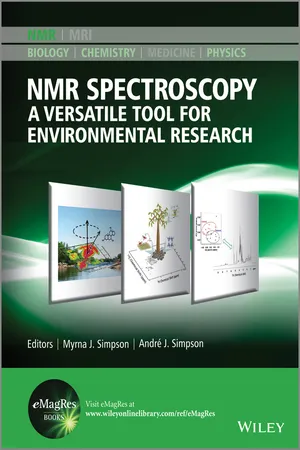
NMR Spectroscopy
A Versatile Tool for Environmental Research
- English
- ePUB (mobile friendly)
- Available on iOS & Android
NMR Spectroscopy
A Versatile Tool for Environmental Research
About this book
The challenges faced by environmental scientists today are vast, complex, and multi-faceted. For instance, predicting the fate of an environmental pollutant or understanding ecosystem responses to climate change, necessitate a firm understanding of molecular structure and dynamics of environmental media as well as the components that exist and interact within this media. Furthermore, linking information obtained at the molecular-scale to ecosystem-level processes is a major pursuit of modern environmental research. As such, NMR spectroscopy and its scalability from the molecular-scale to the macroscopic-scale, is facilitating rapid growth in environmental science. In addition, the versatility of NMR spectroscopy has resulted in the development and implementation of different types of NMR techniques to examine the structure of various types of environmental samples, living and non-living, as well as the study of critical environmental processes.
This comprehensive handbook is a collection of chapters that span from methods to how NMR is used in environmental research to gain insight into various ecosystem properties.
It is organized into three parts:
- Part A focuses on methods used in environmental NMR which span from solution-state to magnetic resonance imaging.
- Part B emphasizes how NMR spectroscopy plays an essential role in understanding various types of environmental components and related processes, including different forms of organic matter found in soil, water, and air as well as how NMR is used to probe the fate of water, organic pollutants, and metals in the environment.
- Part C focuses on the growing field of environmental metabolomics which uses NMR as its main discovery platform.
This volume highlights the immense potential of NMR spectroscopy to expand our fundamental understanding of environmental processes and how it will continue to do so well into the future.
About eMagRes Handbooks eMagRes (formerly the Encyclopedia of Magnetic Resonance ) publishes a wide range of online articles on all aspects of magnetic resonance in physics, chemistry, biology and medicine. The existence of this large number of articles, written by experts in various fields, is enabling the publication of a series of eMagRes Handbooks on specific areas of NMR and MRI. The chapters of each of these handbooks will comprise a carefully chosen selection of eMagRes articles. In consultation with the eMagRes Editorial Board, the eMagRes handbooks are coherently planned in advance by specially-selected Editors, and new articles are written to give appropriate complete coverage. The handbooks are intended to be of value and interest to research students, postdoctoral fellows and other researchers learning about the scientific area in question and undertaking relevant experiments, whether in academia or industry.
Have the content of this handbook and the complete content of eMagRes at your fingertips!
Visit: www.wileyonlinelibrary.com/ref/eMagRes
Frequently asked questions
- Essential is ideal for learners and professionals who enjoy exploring a wide range of subjects. Access the Essential Library with 800,000+ trusted titles and best-sellers across business, personal growth, and the humanities. Includes unlimited reading time and Standard Read Aloud voice.
- Complete: Perfect for advanced learners and researchers needing full, unrestricted access. Unlock 1.4M+ books across hundreds of subjects, including academic and specialized titles. The Complete Plan also includes advanced features like Premium Read Aloud and Research Assistant.
Please note we cannot support devices running on iOS 13 and Android 7 or earlier. Learn more about using the app.
Information
Chapter 1
Environmental NMR: Solution-State Methods
1.1 Introduction
Table of contents
- Cover
- eMagRes Handbooks
- Title Page
- Copyright
- eMagRes
- International Advisory Board
- Contributors
- Series Preface
- Preface
- Abbreviations and Acronyms
- Part A: Fundamentals of Environmental NMR
- Part B: NMR for Air, Soil and Water
- Part C: NMR and Environmental Metabolomics
- Index
- End User License Agreement